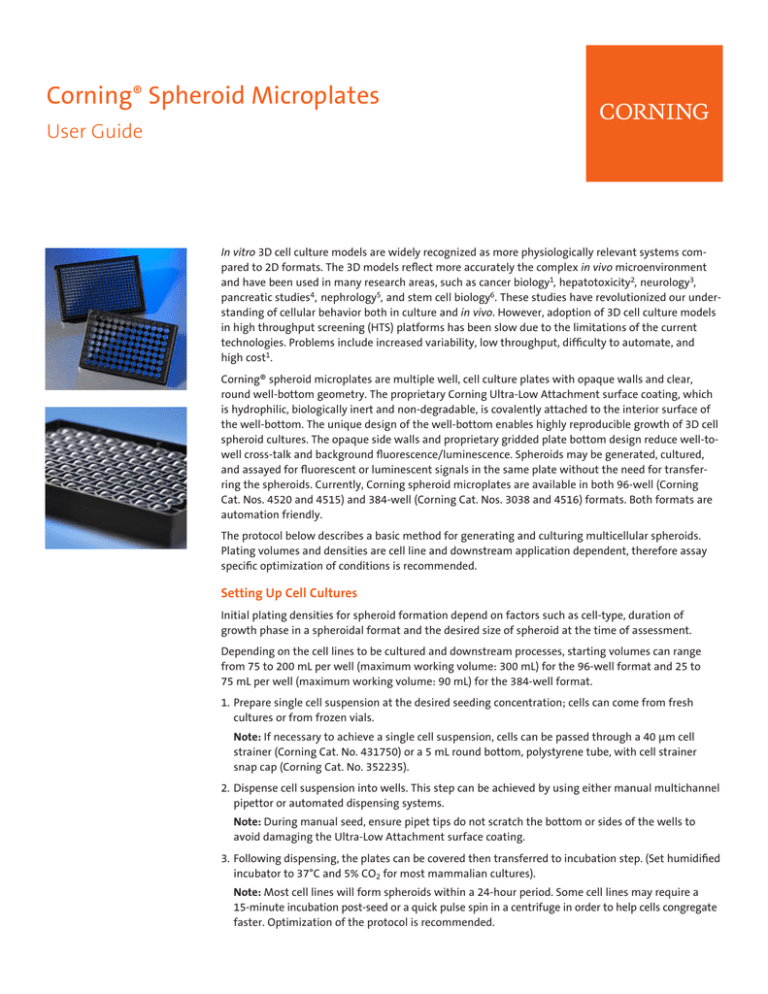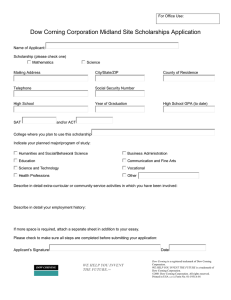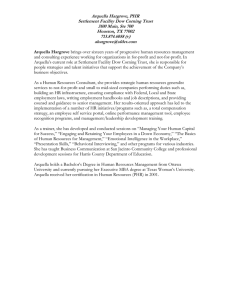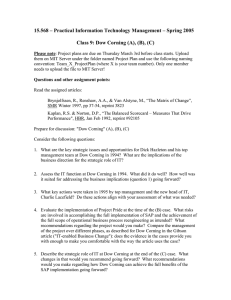
Corning® Spheroid Microplates
User Guide
In vitro 3D cell culture models are widely recognized as more physiologically relevant systems compared to 2D formats. The 3D models reflect more accurately the complex in vivo microenvironment
and have been used in many research areas, such as cancer biology1, hepatotoxicity2, neurology3,
pancreatic studies4, nephrology5, and stem cell biology6. These studies have revolutionized our understanding of cellular behavior both in culture and in vivo. However, adoption of 3D cell culture models
in high throughput screening (HTS) platforms has been slow due to the limitations of the current
technologies. Problems include increased variability, low throughput, difficulty to automate, and
high cost1.
Corning® spheroid microplates are multiple well, cell culture plates with opaque walls and clear,
round well-bottom geometry. The proprietary Corning Ultra-Low Attachment surface coating, which
is hydrophilic, biologically inert and non-degradable, is covalently attached to the interior surface of
the well-bottom. The unique design of the well-bottom enables highly reproducible growth of 3D cell
spheroid cultures. The opaque side walls and proprietary gridded plate bottom design reduce well-towell cross-talk and background fluorescence/luminescence. Spheroids may be generated, cultured,
and assayed for fluorescent or luminescent signals in the same plate without the need for transferring the spheroids. Currently, Corning spheroid microplates are available in both 96-well (Corning
Cat. Nos. 4520 and 4515) and 384-well (Corning Cat. Nos. 3038 and 4516) formats. Both formats are
automation friendly.
The protocol below describes a basic method for generating and culturing multicellular spheroids.
Plating volumes and densities are cell line and downstream application dependent, therefore assay
specific optimization of conditions is recommended.
Setting Up Cell Cultures
Initial plating densities for spheroid formation depend on factors such as cell-type, duration of
growth phase in a spheroidal format and the desired size of spheroid at the time of assessment.
Depending on the cell lines to be cultured and downstream processes, starting volumes can range
from 75 to 200 mL per well (maximum working volume: 300 mL) for the 96-well format and 25 to
75 mL per well (maximum working volume: 90 mL) for the 384-well format.
1.Prepare single cell suspension at the desired seeding concentration; cells can come from fresh
­cultures or from frozen vials.
Note: If necessary to achieve a single cell suspension, cells can be passed through a 40 µm cell
strainer (Corning Cat. No. 431750) or a 5 mL round bottom, polystyrene tube, with cell strainer
snap cap (Corning Cat. No. 352235).
2.Dispense cell suspension into wells. This step can be achieved by using either manual multichannel
pipettor or automated dispensing systems.
Note: During manual seed, ensure pipet tips do not scratch the bottom or sides of the wells to
avoid damaging the Ultra-Low Attachment surface coating.
3. Following dispensing, the plates can be covered then transferred to incubation step. (Set humidified
incubator to 37°C and 5% CO2 for most mammalian cultures).
Note: Most cell lines will form spheroids within a 24-hour period. Some cell lines may require a
15-minute incubation post-seed or a quick pulse spin in a centrifuge in order to help cells congregate
faster. Optimization of the protocol is recommended.
4.Daily monitoring of spheroid formation and growth can be easily done using any microscope.
5.Depending on the cell line and the duration of growth phase in a spheroidal format, a re-feeding
step may be necessary. Spheroids can be fed by adding fresh media to wells or by removing spent
media and dispensing fresh media into the wells.
a. Aspiration and addition of media can be done manually or using an automated liquid handling
system.
b.In order to leave spheroids undisturbed during media changes, sides of wells should be used to
remove and add media.
c. It is recommended that 10 to 20 µL volume be left in the well during media change.
6. Assay/process spheroids in microplate following recommended assay steps, no transfer step
required.
Examples of Multicellular Spheroids in Corning® Spheroid Microplates
Uniform, single mulicellular spheroids (MCS) generated per well.
DU 145 Spheroids in a 96-well Corning Spheroid Microplate
200 cells/well
1,000 cells/well
5,000 cells/well
48 hr
72 hr
DU 145 Spheroids
24 hr
40 cells/well
Hep-G2, HeLa, and HCT-116 Spheroids in a 384-well Corning Spheroid Microplate
5,000 cells/well
10,000 cells/well
20,000 cells/well
HeLa
Hep-G2
72-hour Spheroid Cultures
HCT-116
2,500 cells/well
Scale bar = 1,000 µm
2
10,000 cells/well
Examples of Assay Using Corning® Spheroid Microplates
Cell proliferation and cytotoxicity assay screening
using CellTiter-Glo® 3D Cell Viability Assay (Promega
Cat. No. G9683).
Tumor invasion assay using Cytation™ Cell Imaging
Multi-Mode Reader and Gen5™ Data Analysis
Software (BioTek Instruments, Inc.)
DU 145 spheroid dose response to Doxorubicin over a 72-hour
treatment in a 384-well Corning spheroid microplate.
MDA-MB-231/Fibroblast tumor invasion in a 96-well Corning
spheroid microplate imaged using the Cytation Cell Imaging
Multi-Mode microplate reader. Image reprinted, courtesy of
BioTek Instruments, Inc.
Fluorescence microscopy using LIVE/DEAD® Viability/Cytotoxicity Kit (Life Technologies, Cat. No. L3224).
30 min
1 hr
Within the hour, cells
form a loose aggregate.
6 hr
24 hr 48 hr
Cells pool into a more
defined aggregate.
80 hr
Tight spheroid with
defined edges.
Center of spheroid shows
initial signs of necrosis.
HT-29 spheroid formation over a 3-day period in a 96-well Corning spheroid microplate.
Plate Dimensions to Support Instrumentation Setup
Cat. No.
96-well
384-well
4520
and
4515
3830
and
4516
A1 Row
Offset
(mm)
A1
Column
Offset
(mm)
Well Center
to Well
Center
Spacing
(mm)
Flange
or Skirt
Height
(mm)
Well
Well
Distance
Bottom
Bottom
to
Stack Elevation Thickness Bottom
Height
(mm)
(mm)
of Plate
Well
Volume
(µL)
Well
Depth
(mm)
Well
Diameter
(top/bottom)
(mm)
300
12.36
6.85/6.35
127.6
85.5
14.2
11.2
14.27
9
6.096
13.12
1.86
0.0875
1.86
90
12.54
3.63/2.82
127.6
85.5
14.2
8.99
12.13
4.5
2.41
12.95
1.81
0.0875
1.81
Plate
Length
(mm)
Plate
Width
(mm)
Plate
Height
(mm)
3
Corning® Spheroid Microplate FAQ
Q:How many spheroids are generated per well?
A: The Corning spheroid microplate was designed to generate single, uniform sized spheroids
in every well.
Q:How do I control the size of the spheroids?
A: By altering the initial seeding density, the diameter of the spheroids in the culture can be
­controlled.
Q:Are there any special storage conditions?
A: No. The Corning Ultra-Low Attachment surface is a stable, noncytotoxic, nondegradable,
­biologically inert hydrogel coating that requires no special storage or handling conditions.
Q: What is the advantage of using a round bottom vs. a flat bottom microplate for forming
spheroids?
A: The unique round well bottom design of the Corning spheroid microplate generates single, uniform spheroids, that are centered in each well. This technology is a reliable tool for 3D screening.
Flat bottom wells generate multiple, non-uniform sized spheroids that are not evenly distributed
and lack reproducibility across wells. Because of the variation from well to well, the technology
does not lend itself to high throughput screening.
Q:What are the dimensions of the plate for automation programing?
A: Corning spheroid microplates adhere to the standard ANSI/SBS footprint dimensions for 96-well
and 384-well microplate formats. A plate dimensions guide is provided with this user manual.
Q:What are the plate dimensions with respect to imaging, e.g., the bottom thickness?
A: Well bottom thickness for both 96-well and 384-well formats is 0.0875 mm. Please refer to the
plate dimension guide for more information.
Q:How do I change media when feeding?
A: For a media change you need to remove a portion of the spent media from the wells and replace
it with fresh media. To leave the spheroids undisturbed, we recommend performing this media
change off-center using the sides of wells to remove and add media.
A 50/50 media exchange will be the easiest. For example, to remove 50% of media from a 96-well
format with a 200 μL starting volume, aspirate 100 μL of spent media from the wells, and replace
with 100 μL of fresh media.
For a full media change or wash step for either the 96-well or 384-well format, we recommend
leaving behind a minimum of 10 µL per well. Use the plate dimension guide to program liquid
handling instruments to be 2mm to 3 mm above the bottom of the wells and to be slightly
­off-center.
Q:Will evaporation be an issue, like with the hanging drop technique?
A: No. Evaporation is less of an issue because the spheroids are generated inside the wells. For longterm cultures, especially in the 384-well format, we recommend the use of breathable sealing tape
(Corning Cat. No. 3345) during incubation periods.
Q:What imagers have been validated for compatible use with Corning spheroid microplates?
4
Manufacturer
Instrument Name
BioTek® Instruments, Inc.
Cytation® cell imaging multi-mode reader
Essen Bioscience
IncuCyte ZOOM®
Molecular Devices
ImageXpress® Micro XLS automated imaging system
Nexcelom
Celigo® S image cytometer
TTP Labtech
Acumen® Cellista laser scanning image cytometer
Q: Are there any issues when reading plates while using fluorescent/colorimetric agents?
A: No, Corning® spheroid microplates are specifically designed for assay use. The plates feature optically clear, round bottom wells with a black opaque microplate body. The plate design also includes
a unique well shield to minimize well-to-well cross-talk.
We recommend using Promega CellTiter-Glo® 3D Cell Viability Assay for cell proliferation and
­cytotoxicity assay screening.
Q: Where can I find application notes for Corning spheroid microplates?
A: Corning technical literature can be found online at www.corning.com/lifesciences/cellbasedassays
References
1. Vinci, et al. 2012. Advances in Establishment and Analysis of Three Dimensional Tumor Spheroid-based
Functional Assays for Target Validation and Drug Evaluation. BMC Biology 10:29.
2. Godoy P., et al. 2013. Recent Advances in 2D and 3D In Vitro Systems Using Primary Hepatocytes, Alternative
Hepatocyte Sources and Non-parenchymal Liver Cells and Their Use in Investigating Mechanisms of
Hepatotoxicity, Cell Signaling and ADME. Arch. Toxicol. 87(8):1315-1530. Pubmed/23974980.
3. Lai, et al. 2011. Neural Cell 3D Microtissue Formation is Marked by Cytokines’ Up-regulation. PLoS One
6(10):e26821.
4. Jun Y. 2013. 3D Co-culturing Model of Primary Pancreatic islets and Hepatocytes in Hybrid Spheroid to Overcome
Pancreatic Cell Shortage. Biomaterials 34(15):3784-3794.
5. Astashkina, et al. 2012. A 3-D Organoid Kidney Culture Model Engineered for High-Throughput Nephrotoxicity
Assays. Biomaterials 33:4700-4711.
6. Sasai Y. 2013. Next-Generation Regenerative Medicine: Organogenesis from Stem Cells in 3D Culture. Cell Stem
Cell 12(5):520-530.
Warranty/Disclaimer: Unless otherwise specified, all products are for research use only. Not intended for use in
diagnostic or therapeutic procedures. Corning Life Sciences makes no claims regarding the performance of these
products for clinical or diagnostic applications.
5
Beginning-to-end
Solutions for
Drug
Discovery
At Corning, we continuously strive towards improving efficiencies and developing new products and
technologies for life science researchers. From assay preparation to storage, our technical experts understand
your challenges and your increased need for high-quality products.
It is this expertise, plus a 160-year legacy of Corning innovation and manufacturing excellence, that puts
us in a unique position to be able to offer a beginning-to-end portfolio of high-quality, reliable life sciences
consumables.
For additional product or technical information, please visit www.corning.com/lifesciences
or call 1.800.492.1110. Outside the United States, please call 978.442.2200.
Corning Incorporated
Life Sciences
836 North St.
Building 300, Suite 3401
Tewksbury, MA 01876
t 800.492.1110
t 978.442.2200
f 978.442.2476
www.corning.com/lifesciences
Worldwide
Support Offices
ASIA/PACIFIC
Australia/New Zealand
t 0402-794-347
China
t 86 21 2215 2888
f 86 21 6215 2988
India
t 91 124 4604000
f 91 124 4604099
Japan
t 81 3-3586 1996
f 81 3-3586 1291
Korea
t 82 2-796-9500
f 82 2-796-9300
Singapore
t 65 6733-6511
f 65 6861-2913
Taiwan
t 886 2-2716-0338
f 886 2-2516-7500
For a listing of trademarks, visit us at www.corning.com/lifesciences/trademarks.
All other trademarks in this document are the property of their respective owners.
EUROPE
France
t 0800 916 882
f 0800 918 636
Germany
t 0800 101 1153
f 0800 101 2427
The Netherlands
t 31 20 655 79 28
f 31 20 659 76 73
United Kingdom
t 0800 376 8660
f 0800 279 1117
All Other European
Countries
t 31 (0) 20 659 60 51
f 31 (0) 20 659 76 73
LATIN AMERICA
Brasil
t (55-11) 3089-7419
f (55-11) 3167-0700
Mexico
t (52-81) 8158-8400
f (52-81) 8313-8589
© 2014, 2015 Corning Incorporated. All rights reserved. Printed in U.S.A 4/15 CLS-AN-235 REV3
www.corning.com/lifesciences/solutions





